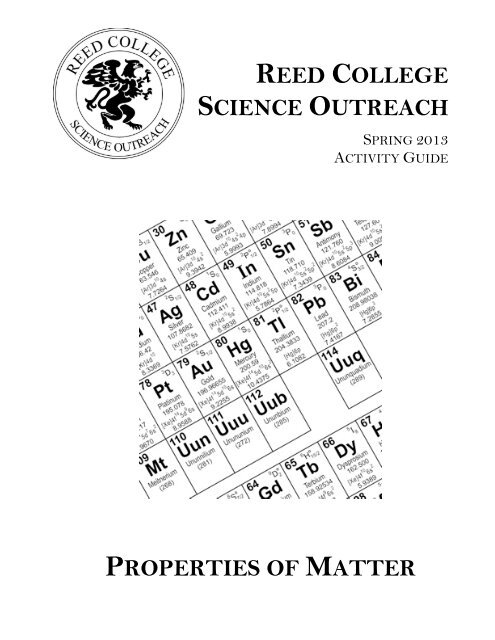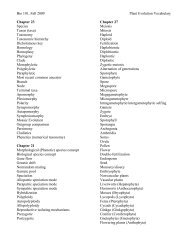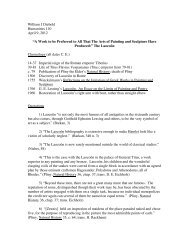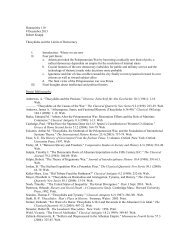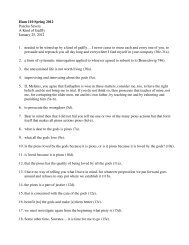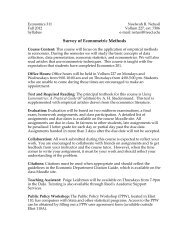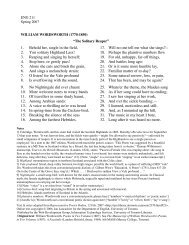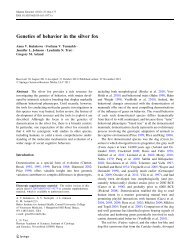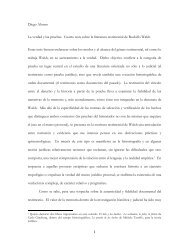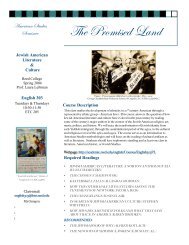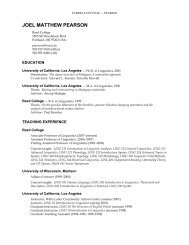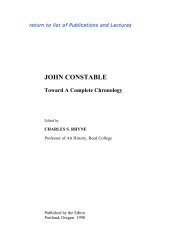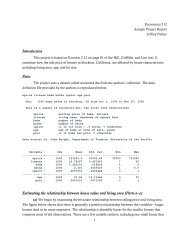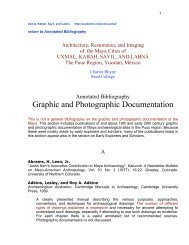REED COLLEGE SCIENCE OUTREACH PROPERTIES OF MATTER
REED COLLEGE SCIENCE OUTREACH PROPERTIES OF MATTER
REED COLLEGE SCIENCE OUTREACH PROPERTIES OF MATTER
You also want an ePaper? Increase the reach of your titles
YUMPU automatically turns print PDFs into web optimized ePapers that Google loves.
<strong>REED</strong> <strong>COLLEGE</strong><br />
<strong>SCIENCE</strong> <strong>OUTREACH</strong><br />
SPRING 2013<br />
ACTIVITY GUIDE<br />
<strong>PROPERTIES</strong> <strong>OF</strong> <strong>MATTER</strong>
2 Reed Biology Outreach<br />
Reed College Science Outreach Program<br />
2012-2013<br />
Manual compiled by:<br />
Kristy Gonyer, Outreach Coordinator<br />
Special thanks:<br />
Many of the lessons in this unit are based on units compiled in earlier years by Thea True,<br />
Laurie Hausch, Kelly Fellows, and Juliana Arrighi. Previous lessons and those included in this<br />
manual benefited from the contributions of Reed College Faculty including Robert Kaplan and<br />
Arthur Glasfeld. I thank them for the work that they put into developing these lessons.<br />
Finally, thank you to Li Zha, Cole Perkinson, and OMSI for their support in adapting and<br />
implementing the chemistry lessons in this manual.<br />
Acknowledgements:<br />
Funding provided by<br />
Reed College & donations by:<br />
An Duclos in memory of her son Levi &<br />
Diane Perkinson<br />
Thanks for the support and guidance of our classroom teachers!<br />
Portland Public Schools and David Douglas School District faculty:<br />
Beach Elementary School<br />
Kristi Burnham<br />
Grout Elementary School<br />
Marika Bilter<br />
Jonathan Ficher<br />
Brian Gilroy<br />
Sally Stephenson<br />
Lewis Elementary<br />
Paul Colvin<br />
Sarah Kohn<br />
Abby Rotwein<br />
Sylvia Jen<br />
Matthew Marchyok<br />
Lent Elementary School<br />
Sarah Meyers<br />
Lincoln Park Elementary<br />
Sara Camp<br />
Chris Healey<br />
Sam Wallace<br />
Pioneer Special School Program<br />
Christopher Marquardt<br />
Paul Pierson<br />
Dan Wilson<br />
Brandon Breedon<br />
Vernon School<br />
Brad Johnson<br />
Karanja Crews
3<br />
Table of Contents<br />
Table of Contents ................................................................................................................. 3<br />
Tentative Schedule............................................................................................................... 3<br />
Outreach Calendar................................................................................................................ 4<br />
Lesson One- Exploring States of Matter ......................................................................... 6<br />
Lesson Two- What is Matter? ......................................................................................... 10<br />
Lesson Three- Exploring Electricity.............................................................................. 14<br />
Lesson Four- Exploring Magnetism ............................................................................... 19<br />
Lesson Five- What is pH? ................................................................................................. 22<br />
Lesson Six- Exploring Solubility..................................................................................... 26<br />
Lesson Seven- What is a Chemical Reaction? .............................................................. 29<br />
Lesson Eight- Mystery Powders...................................................................................... 32<br />
Tentative Schedule<br />
Observation & Pre-Lesson-<br />
Lesson 1. Exploring the Properties of Matter, States of Matter<br />
Lesson 2. Exploring the Properties of Matter, Atoms & Molecules<br />
Lesson 3. Exploring the Properties of Matter, Electricity<br />
Lesson 4. Exploring the Properties of Matter, Magnetism<br />
Lesson 5. Exploring the Properties of Matter, What is pH?<br />
Lesson 6. Exploring the Properties of Matter, Solubility<br />
Reed’s Spring Break- No Outreach<br />
Portland Public Schools Spring Break- No Outreach<br />
L7. Properties of Matter, What is a Chemical Reaction?<br />
L8. Exploring the Properties of Matter, Mystery Powders<br />
Make up weeks & Optional Field Trips to Reed Reactor & Science Labs<br />
Jan 28-<br />
Feb 1<br />
Feb<br />
4-8<br />
Feb<br />
11-15<br />
Feb<br />
18-22<br />
Feb 25-<br />
March 1<br />
March<br />
4-8<br />
March<br />
11-15<br />
March<br />
18-22<br />
Mach<br />
25-29<br />
April<br />
1-5<br />
April<br />
8-12<br />
April<br />
15-26
4<br />
Outreach Calendar<br />
January<br />
20<br />
21<br />
22 23 24 25<br />
26<br />
Paideia<br />
MLK Day<br />
LP Closed<br />
27<br />
28<br />
29 30 31 1<br />
2<br />
Observation<br />
& Training<br />
February<br />
Reed Starts<br />
Outreach<br />
Meeting<br />
5/5:30???<br />
PPS Closed<br />
3<br />
4 5 6 7 8 9<br />
Week 1<br />
10<br />
11 12 13 14 15<br />
16<br />
Week 2<br />
17<br />
Week 3<br />
24<br />
Week 4<br />
18<br />
PPS/LP<br />
Closed<br />
19 20<br />
PPS Late<br />
25 26 27 28 1<br />
LP Closed<br />
21 22 23<br />
LP Closed<br />
2<br />
March<br />
3<br />
Week 5<br />
10<br />
4 5 6 7 8 9<br />
11 12 13 14 15 16<br />
Week 6<br />
17<br />
Reed Spring<br />
Break<br />
24<br />
PPS/ LP<br />
Spring<br />
Break<br />
18 19 20<br />
25<br />
PPS/ LP<br />
Closed<br />
26<br />
PPS/ LP<br />
Closed<br />
PPS Late<br />
27<br />
PPS/ LP<br />
Closed<br />
21 22 23<br />
28<br />
PPS/ LP<br />
Closed<br />
29<br />
PPS/ LP<br />
Closed<br />
30
5<br />
April<br />
31<br />
1 2 3 4 5<br />
6<br />
Week 7<br />
7<br />
Week 8<br />
14<br />
Make-up<br />
Week<br />
21<br />
Make-up<br />
Week<br />
28<br />
Make-up<br />
Week<br />
8 9 10 11<br />
15 16 17<br />
PPS Late<br />
LP Closed<br />
LP Closed<br />
12<br />
PPS/LP<br />
Closed<br />
13<br />
18 19 20<br />
22 23 24 25 26 27<br />
29 30 1 2 3<br />
Last Day of<br />
Classes<br />
4<br />
May<br />
5<br />
Field Trips<br />
12<br />
6<br />
Reading<br />
Week<br />
13<br />
7 8 9<br />
Outreach<br />
Party 5pm<br />
10 11<br />
14 15 16 17 18<br />
Field Trips<br />
Finals<br />
19 20<br />
21 22 23 24 25<br />
Graduation<br />
26 27 28 29 30 31 1
6<br />
Lesson One- Exploring States of Matter<br />
Objectives<br />
o Students will begin to learn about matter and some of matter’s properties.<br />
o Students will learn about the three most common states of matter and observe<br />
changes between the three states of matter.<br />
Lesson Background- The Three States of Matter<br />
For the next eight weeks we will be studying a few of the basic chemical and physical<br />
properties of matter. Each lesson will focus on a different property of matter.<br />
o What is matter? Matter is everything in the world that takes up space and has<br />
mass. Matter makes up everything in the world and there are many different<br />
kinds of matter. These different types of matter have different properties.<br />
Today students will begin to explore one of the fundamental physical properties of<br />
matter. Students will learn that matter on Earth exists in one of three states: solid,<br />
liquid, or gas (matter also can take the form of plasma, but temperatures are usually too<br />
cool on Earth for plasma to form). Each state has specific physical characteristics.<br />
• Solids hold a particular shape.<br />
• Liquids have no particular<br />
shape of their own. They take<br />
the shape of the container<br />
they are poured into.<br />
• Gasses expand or contract to<br />
fill the space of whatever<br />
container holds them,<br />
whether it is a balloon or a<br />
room.<br />
When a substance changes from one phase to another, heat energy is either emitted or<br />
absorbed. The processes of changing phases are:<br />
• Melting-going from a solid to a liquid (heat energy in)<br />
• Freezing-going from a liquid to a solid (heat energy out)<br />
• Evaporation- going from a liquid to a gas (heat energy in),<br />
• Condensation-going from a gas to a liquid (heat energy out)<br />
• Sublimation-going from a solid to a gas (heat energy in)<br />
• Deposition- going from a gas to a solid (heat energy out)
7<br />
Week Three Activity Overview<br />
Today’s activity will begin with a demonstration to introduce students to some of the<br />
properties of matter that they will learn about this spring. In front of the class you will<br />
drop a piece of dry ice into a graduated cylinder full of cabbage juice. The juice will<br />
begin to bubble violently as the dry ice sublimates producing a carbon dioxide gas<br />
(here you can review states of matter). The CO2 will slowly react with the water to form<br />
a weak carbonic acid, which will cause the cabbage juice to change colors (signs of a<br />
chemical reaction as the pH changes). Students will learn more about the changes that<br />
they observe in this demonstration later in the semester.<br />
For the rest of the lesson, the students will explore freezing points and changes in the<br />
states of matter by making homemade sorbet (sorbet will be made rather than ice-cream<br />
because of allergy concerns).<br />
Demo Materials<br />
o Graduated cylinder<br />
o Tray<br />
Activity Materials<br />
o Gloves<br />
o Ziplock bags, fruit juice, rock<br />
salt, & ice cubes (for freezing<br />
experiment)<br />
o Cabbage juice<br />
o Dry ice pieces<br />
o Cups, spoons, napkins for<br />
serving sorbet<br />
Lesson Plan<br />
Introduction to Matter (5-10 Minutes):<br />
Note: Remember to leave some time to remind students of your names (or to introduce yourself if<br />
you are new) and to point out the question box.<br />
1. On the overhead, point out the first word on the students’ “Science Toolbox”: matter.<br />
Tell students that matter is the scientific word for all the stuff that makes the universe.<br />
Tell the students that there are many different types of matter and that these different<br />
types of matter have different types of properties. Ask students if they can think of<br />
different properties in the matter they see around them (i.e. my pencil lead is grey, my<br />
desk is smooth, my book is heavy, etc.).<br />
2. Tell students that today we are going to learn about another very important<br />
property: the states of matter. Ask students if they can remember the three states. List<br />
the states on the overhead, and then ask the students to describe the characteristics of<br />
the three states.
8<br />
3. Ask the students how matter can change from one state to another. Explain to the<br />
students that solids can melt into a liquid and then evaporate into a gas if heat is<br />
added to the matter. Tell students that all matter can melt and evaporate; it just has to<br />
be very hot sometimes. Remind students that if matter looses heat it can also condense<br />
into a liquid and freeze into a solid. You might want to have the students fill out the<br />
vocabulary section in “My Science Toolbox” at this point.<br />
Demonstration (15 Minutes):<br />
4. Today’s activity will start with a demonstration to introduce students to some of the<br />
properties of matter that they will learn about this spring.<br />
5. Find a place where the entire class can see you perform the demo. After donning your<br />
safety gear, place a graduated cylinder inside a tray to catch any spills. Fill the cylinder<br />
halfway with cabbage juice. Briefly brainstorm some of the juice’s properties (color etc.).<br />
6. Then, bring out a piece of dry ice and discuss the dry ice’s properties. Be sure to point<br />
out the change in states as the dry ice sublimates from solid to gas. Next drop the ice<br />
into the cabbage juice and ask the students to point out changes in the properties of the<br />
juice. Tell the students that for the next several weeks we will learn more about the<br />
properties of matter and how different types of matter interact with each other.<br />
Freezing Experiment (20-25 Minutes):<br />
7. Tell students that they are now going to start an experiment about freezing. Explain<br />
the concept of freezing point and how the salt lowers the freezing point of water. Tell<br />
students that different types of matter freeze, evaporate, melt, etc. at different<br />
temperatures. For example, water usually freezes at 32˚F or 0˚C. However if you add<br />
salt, it changes the properties of the water so that it will start melting will be lower (the<br />
amount of salt will determine the exact melting/freezing point).<br />
½ cup fruit juice<br />
2 cups ice<br />
1 Tbs salt<br />
Sorbet in a Bag<br />
1. Pour the juice into a plastic baggie that has a zipper. Close the bag.<br />
2. Add the ice, and salt to a larger bag.<br />
3. Place the bag of juice inside the baggie containing the ice, salt and water.<br />
4. Shake, shake, shake the bag until the sorbet is the consistency you want. Remove<br />
the inner bag, scoop out your frozen treat, and enjoy!<br />
How It Works<br />
Salt, or sodium chloride, dissociates into sodium and chloride ions. These ions act as<br />
impurities in the water lowering its freezing point. Energy is absorbed from the<br />
environment (the sorbet) as the ice changes phase into water, which can't release the<br />
energy by solidifying back into ice. Therefore the sorbet keeps getting colder as the<br />
ice melts.
9<br />
8. Pass a small sample of fruit juice and have students make observations of their<br />
sample. Students should also take an initial temperature reading. (Sample juice should<br />
be dumped down the sink once they are done with it…No drinking! These samples are<br />
part of an experiment!)<br />
9. While students are making observations you should pass out gloves and sandwichsized<br />
Ziploc bags. You should also begin adding 1 Tbs of ice to the pre-prepared gallon<br />
sized bags of ice.<br />
10. Once students have finished their observations, have students wash their hands and<br />
put on their gloves. The students can then line up to fill their sandwich bags with ½ cup<br />
fruit juice in their small bag. The students should then seal their juice bag and place it<br />
into a bag with ice and salt. They should then go back to their seats and shake for 5-10<br />
minutes until the juice begins to freeze.<br />
11. After their sorbet is solid, they should open their ice bag over the sink (or the cooler<br />
if there is a long line). They should dump their ice into the sink, but retain their frozen<br />
juice. Make sure to give students paper towels to clean up any messes. The bags etc. can<br />
be thrown away.<br />
12. Before they dig into their sorbet, have students take a small sample and place it in a<br />
cup. How does it look now? What temperature is it now?<br />
13. Once students have cleaned up, they can enjoy their sorbet while completing their<br />
worksheets.<br />
Experiment Wrap-up and Conclusion (10-15 Minutes):<br />
14. Discuss the results as a class. What happened to the ice when salt was added? Were<br />
solids or liquids warmer?<br />
15. Finish by cleaning everything up and passing out stickers to students who<br />
completed their worksheets. If time allows, check for questions in the Question Box.
10<br />
Lesson Two- What is Matter?<br />
Objectives<br />
o Students will learn that matter is made up of atoms & molecules.<br />
o Students will learn that there are many kinds of atoms that give matter its<br />
unique properties.<br />
o Students will learn that atoms can form bonds with other atoms to form<br />
molecules with new properties.<br />
Lesson Background— Atoms and Molecules<br />
So far students have learned that the world is made up of matter and that different types<br />
of matter that have different properties. Today students will learn that matter is made<br />
up of atoms and molecules.<br />
Matter is made up of tiny atoms that are too small for us to see even with an optical<br />
microscope (although there are electron microscopes that allow us to see them). Atoms<br />
are measured in Angstroms, which are 1/10,000,000,000 of a meter (very, very small).<br />
There are many types of atoms, each with their own properties, which is why there are<br />
so many types of matter. Each different type of atom is called an element. Right now<br />
scientists have discovered 118 different types of elements (and they continue to discover<br />
new ones). Scientists have made a chart of the elements called the periodic table of<br />
elements.<br />
This table contains important information about the atoms. Even though atoms are very<br />
small, they are made up of even smaller parts. Atoms consist of a nucleus, which is<br />
made up of tiny little particles called protons and neutrons. Protons are very<br />
important. Some atoms have many protons and others only have a few. Each element<br />
has a specific number of protons and they help to determine the element’s unique
11<br />
properties. The periodic table tells you how many protons each element has. Around the<br />
nucleus are other particles called electrons. Atoms usually (but not always) have the<br />
same number of neutrons and electrons as protons.<br />
Electrons are also very important particles. Most atoms don’t like to be alone. They like<br />
to interact with other atoms. When atoms interact, the atoms’ electrons form a bond<br />
that holds the atoms together. These bonded atoms form a bigger piece of matter called<br />
a molecule. Molecules can be made up of all one kind of atom (like oxygen gas—02) or<br />
more than one kind of atom (like water—H20). Often molecules form new types of<br />
matter that have completely new properties (i.e. water vs. very flammable H2 or O2).<br />
Because atoms and molecules are so small, many people, including scientists, build<br />
models to better understand something that can be difficult to picture. Chemistry<br />
students often use molecular models when they’re learning about how molecules behave<br />
and computer-generated models are used in research as well. Today we will learn about<br />
some common molecules using models.<br />
Activity overview<br />
Today, students will use models to build molecules. The exercise will help emphasize<br />
how different types of molecules form bonds to create molecules. Be sure to emphasize<br />
the changes in properties that molecules undergo when they form new molecules.
12<br />
Materials<br />
o Molecule Building Kits<br />
Lesson Plan<br />
Review & Introduction (5–10 Minutes):<br />
Note: Remember that this lesson in only an introduction to atoms and molecules. Try to not get<br />
bogged down in the details. Just stick to the basics and be sure to leave more time for the activity<br />
than the introduction.<br />
1. Have students remind you about the different properties we have learned about so far<br />
(magnetism, states, etc.). Ask students why they think different types of matter have<br />
different properties.<br />
2. Tell students that matter is actually made up of very tiny particles called atoms. All<br />
matter is made up of these tiny particles. Put up an overhead of a periodic table. Explain<br />
that there are at least 118 different types of atoms, and each type of atom is called an<br />
element. Scientists created this table to list all the types of elements that have been<br />
discovered so far.<br />
3. Ask students if they have ever heard of the element carbon. Does anyone know what<br />
it looks like? Have student look at the graphite in their pencils, and tell them the<br />
graphite is made up of trillions of carbon atoms. Tell them that carbon (and all other<br />
atoms) has unique properties because of the way it is built.<br />
4. Show a picture of a carbon atom. Point out that it is made up of even tinier particles.<br />
Go through each part of the carbon atom, having students label the particles in their<br />
worksheets. Be sure to emphasize that the protons are the particles that give carbon<br />
(and all other atoms) its unique properties. Also point out how the periodic table tells<br />
the students how many protons each element has. To check comprehension, ask<br />
students: Do any two elements have the same number of protons?<br />
5. Finally, tell students that electrons also play an important role. Inform students that<br />
most atoms don’t like to be alone. They like to interact with other atoms. The electrons<br />
are the part of the atom that helps it to form bonds (like a friendship) with other atoms.<br />
Sometimes atoms will form bonds with the same kind of atom and sometimes atoms will<br />
form bonds with other kinds of atoms. These bonded atoms are called molecules.<br />
Molecule Modeling (35–40 Minutes):<br />
6. Ask student to open their science notebooks to the molecule-modeling activity. Tell<br />
students that today we are going to explore how atoms form bonds with each other.<br />
Tell students that we will do the first two exercises together to help them understand<br />
what to do.<br />
7. Before you pass out the kits, do the first example as a demonstration. Point out the<br />
chart that lists the elements that students will work with today. Point out how each<br />
element has its own properties. One of the properties that each element has is that they
13<br />
like to form a certain number of bonds. (It is like how some people like to have just one<br />
close friend, while others like to have lots of friends). Point out that hydrogen only likes<br />
to form one bond, while the others like to form many bonds. Show the students the<br />
Styrofoam balls in the kit. Each ball represents a different type of atom. The chart lists<br />
the color of each atom.<br />
8. Have students look at the first exercise in their science notebook. Point out that the<br />
instructions are like a recipe. For the first exercise, show students how the “recipe”<br />
shows them they will need 2 oxygen atoms. Tell students that they should then look at<br />
the chart for 2 pieces of information. 1.) What color are the oxygen atoms (red) and 2.)<br />
how many bonds do the oxygen atoms want (2)? Show students the toothpicks that will<br />
represent the bonds. Show the students how the two oxygen molecules will form with<br />
two bonds shared between them. Have the students draw the molecule in their<br />
worksheets.<br />
9. Tell the students that we will do the next one together as a class. The next exercise is<br />
water. Ask the students what elements we will need for this puzzle (2 hydrogen and 1<br />
oxygen). What colors are those atoms? How many bonds does each atom want? How<br />
can we put the atoms together to make everyone “happy”? Hopefully a student will<br />
suggest that the oxygen atom will share one bond with each of the two hydrogen atoms.<br />
10. Tell students to work on the rest of their molecules individually or in groups of two<br />
to complete the rest of the exercises. Walk around to help students as they work on the<br />
exercises. (If any students finish early, you will have a challenge sheet available).<br />
Wrap-up (10–15 Minutes):<br />
11. As students wrap up, have the students put their kits back in their bags (made sure<br />
to look for lost atoms and bonds on the floor). Ask students which ones were easy and<br />
which ones were more difficult. Ask the students if they noticed the descriptions of the<br />
new molecule’s properties. Do the new molecules have the same properties as the<br />
elements in them?<br />
12. Be sure to pass out stickers to students who completed their worksheets. If time<br />
allows, check for questions in the Question Box.
14<br />
Lesson Three- Exploring Electricity<br />
Objectives<br />
o Students will learn that the flow of electrons is responsible for electricity.<br />
o Students will learn that certain types of matter are better conductors of<br />
electricity than others.<br />
Lesson Background- Electricity<br />
This week, students will review the parts of an atom and learn that the flow of electrons<br />
is responsible for electricity, which powers the electronic devices we use everyday.<br />
They will be introduced to the concepts of electricity, circuits, and voltage by building<br />
batteries with four different types of fruit and using the circuits to power LEDs. They<br />
will also review the scientific method and develop their quantitative skills by recording<br />
the voltages produced by each type of fruit in a table of results. This week, students<br />
should learn that<br />
o An electron is a basic component of every atom that is responsible for creating<br />
current.<br />
o Current is the flow of electrons through a material.<br />
o Voltage is a measure of how strongly electrons are being pushed through a<br />
material (in general, increasing voltage will produce a stronger current, just like<br />
increasing the pressure in a hose will force more water through the hose).<br />
o Resistance is a measure of how tightly a material holds its electrons (if a<br />
material has a higher resistance, then it is harder for current to flow through it,<br />
similar to how a kink in a hose makes it harder for water to flow through it).<br />
o A circuit is a path through which electrons can flow.<br />
Week Two Activity overview<br />
Today, students will build batteries using fruit, use their batteries to power LEDs, and<br />
determine which of four fruits makes the most effective battery.<br />
Materials<br />
o Fruit, roughly equivalent in size:<br />
either lemons, apples, oranges,<br />
or tomatoes<br />
o Copper nails (~1.5” in length)<br />
o Galvanized zinc nails (~1.5” in<br />
length)<br />
o Small red LED with ~2” leads<br />
o 9 alligator clip connectors<br />
o Voltmeter with alligator clip<br />
probes
15<br />
Lesson Plan<br />
Review & Introduction to Electricity (10 Minutes):<br />
Note: This activity has a lot of parts, and it is important to leave plenty of time for the<br />
actual activity. Try to introduce the terms in bold below simply and clearly, and avoid<br />
getting bogged down in excessive detail.<br />
1. Review the steps of the scientific method (OHECK) with the class. Then ask students<br />
to remind you what they learned about atoms last week. Make sure students know that<br />
the electron is a basic component of all atoms. (To give them a picture of how small the<br />
electron is, mention that if an electron were the size of an apple, humans would be 3.5<br />
times the size of the solar system!)<br />
2. Tell students that today we are going to learn about another special property of<br />
matter. Ask your students what they know about electricity. Describe electricity as a<br />
form of energy created by electrons. Sometimes atoms can give up their electrons, which<br />
can then begin to move through materials such as wire. When these electrons are in<br />
motion, we get current; current is the flow of electrons through a material. (You might<br />
make an analogy to current in a river.) This current is used to power all of our electrical<br />
appliances.<br />
3. Now have students picture a garden hose. What causes water to flow through the<br />
hose? Generally, pressure is needed to make water flow up the hose so that you can,<br />
say, water your plants. Similarly, a pressure is needed to make electrons flow through a<br />
material. This pressure is called voltage. Voltage is a measure of how strongly<br />
electrons are being pushed through a material, just like pressure is a measure of how<br />
strongly water is being forced through your garden hose.<br />
4. Now, it is also possible that there is a kink, or sharp bend, in your garden hose. What<br />
happens then? Well, even if the pressure in the hose is very high, the kink probably<br />
stops very much water from being able to pass through the hose. In a similar way,<br />
atoms that don’t like to give up their electrons will slow the flow of electrons through a<br />
material. This is called resistance. Resistance is a measure of how tightly a material<br />
holds onto its electrons. (If a material has a high resistance, it will be harder for electrons<br />
to flow through it.)<br />
5. Now imagine putting your hand over the end of your garden hose. If you turn the<br />
hose on slowly, water will gradually pile up in the hose until the hose is completely<br />
filled with water. The same sort of thing happens with electrons. If you block the<br />
electrons, they will start to pile up until they can’t flow any more. Usually, for a current<br />
to exist, we need a complete, unblocked path for the electrons to flow around. This electron<br />
path is called a circuit. A circuit is a path through which electrons can flow. (Remind<br />
the students of the electromagnet that they built... To form the magnetic field around<br />
the iron nail, we created an electric circuit that flowed from the battery through the<br />
wire around the nail and back into the other side of the battery...)<br />
6. As a check before you go on, ask a few different students to define current, voltage,<br />
resistance, and/or circuit. We’re only asking students to get a very basic, general idea<br />
of the concepts, so don’t worry too much about the nitty-gritty details. You might want<br />
to have the students fill out the vocabulary section in “My Science Toolbox” at this<br />
point.
16<br />
Building Fruit Batteries (30 minutes)<br />
7. Tell students that today they will be working together in groups of 4 to build<br />
batteries using fruit (either lemons, apples, oranges, or tomatoes). How is this even<br />
possible? Somehow, electrons must be able to travel through the fruit. When this<br />
happens, we say the fruit conducts electricity. It turns out that citric acid (found in tart<br />
fruits) allows electrons to flow more easily through sour fruits than through regular<br />
water.<br />
8. Before you begin, have the students write down their hypotheses to the question,<br />
“Which fruit will make the most effective battery?” in the indicated spots on their<br />
worksheets.<br />
9. Now distribute the supplies to each table (4 fruits, 4 copper nails, 8 zinc nails and 5<br />
alligator clip connectors— save the LED for later). Tell the students that you will be<br />
giving them step-by-step directions, so they need to be very good listeners. Let the<br />
students know not to eat the fruits, as they may get contaminated during the activity.<br />
Instruct each student to take 1 fruit, 1 of copper nail, 2 zinc nails and 1 alligator clip<br />
connector. As you give the students instructions, you should also follow along on the<br />
overhead, while your teammates help the students.<br />
10. When the class is ready, have the students take their fruits into their hands and roll<br />
the fruit between their palms while gently squeezing. Explain that this will soften up<br />
the fruit and make it easier for current to flow through it. (Try to avoid rupturing the<br />
skin of the fruit if you can.)<br />
11. Now have students take their copper nails and push it gently about 1” into one side<br />
of the fruit. Then have the students take one of the zinc nails and push it about 1” into<br />
the other side of the fruit so that the tips of the nails are close, but not touching. Add<br />
the second zinc nail right next to the first (Fig 1).<br />
Fig. 1. How to insert nails into the fruit. The nails can be a bit closer than in the picture above,<br />
but make sure they are not touching or the battery won’t work!<br />
12. Once everyone has prepared his or her fruit with nails, remind the students that<br />
these fruits are actually little batteries. Copper holds onto its electrons more forcefully<br />
than zinc does, so the electrons want to flow from the zinc nail to the copper nail. (This<br />
is like an electron tug-of-war between copper and zinc, and copper is winning!)<br />
13. Tell students that scientists measure how strong a battery is by using a device called<br />
a voltmeter. (Hold up a voltmeter for everyone to see.) We can use this device to<br />
measure the voltage of our fruit batteries. Remind students what voltage is by having a<br />
student define it for you. (Voltage is a measure of how strongly the battery is pushing<br />
on the electrons to create a current.) Demonstrate how a voltmeter works on the<br />
overhead by holding the two probes of the voltmeter against the two nails on the
17<br />
sample fruit that you prepared. Say that voltage is measured in units called volts (how<br />
many volts a battery produces says how powerful the battery is).<br />
14. Tell the students that you are going to go around and measure the voltage of one of<br />
each type of fruit. When you measure the voltage of each type of fruit, announce the<br />
voltage to the class, and have them enter the value into the table on their worksheet.<br />
(The voltage reading might fluctuate, but the reading should be somewhere in the 0.1–<br />
1.0 V range, and probably larger for the lemons and tomatoes than for the apples and<br />
oranges.)<br />
15. Tell the students that we are going to try to use the energy from our fruit batteries<br />
to power little red lights called LEDs (light-emitting diodes). Put the diagram of the<br />
lemon battery circuit up on the projector for the class to see. Inform the class that each<br />
line going from one nail to another represents one of the alligator clip connectors. Have<br />
students attach one end of their alligator clips to their copper nails. (Tell the students to<br />
be careful so that they don’t pinch their fingers.)<br />
16. Now have the students arrange their fruits in the middle of their tables in a line, as<br />
shown in the figure. Tell the students to make sure that all of the copper nails point in<br />
one direction and that all of the zinc nails point in the other direction. (This is essential<br />
in order for the batteries to work properly.)<br />
17. Have the students work cooperatively to attach all of their alligator clips to the nails<br />
so that it matches the diagram displayed on the board. Tell the students to work<br />
together so that each person has a chance to connect their alligator clip connector to the<br />
circuit. (Five alligator clips will be needed in total.) You will want to have a couple Reed<br />
teachers circle the class to assist any confused students with their alligator clips.<br />
18. After you see that each group is complete, tell them that a Reed teacher will go<br />
around the room and attach an LED to each circuit. For each table, do a once-over of<br />
the circuit to make sure it is correct before attaching the LED. Make sure the long leg<br />
of the LED (this side will be bent to distinguish it) is attached to the copper side of the<br />
circuit and the short end of the circuit is attached to the zinc side of the circuit, as<br />
depicted in Fig. 2. (This is essential because current only travels through LEDs in one<br />
direction.)<br />
Fig. 2. Complete fruit circuit with LED attached. Make sure the fruits are aligned as shown, and<br />
then attach the LED with the bent leg is connected to a copper nail.<br />
19. Have a student at the table look very closely at the LED and tell the class if they can<br />
see any light being produced. (The light will be dim, so it may help to turn the lights off<br />
temporarily for this part of the activity. Also make sure that the student look at the end<br />
of the LEDs...the sides don’t glow.)
18<br />
After confirming the student’s finding, have the students circle “yes” or “no” in their<br />
results table in the appropriate row. Remind the students not to be disappointed if their<br />
circuit doesn’t manage to make the LED light up; it just means that their type of fruit<br />
does not make as effective of a battery as others.<br />
20. Go to each of the other tables, attach an LED, assign a student at the table to tell<br />
the class if they can see any light being produced, and have the class fill out the<br />
appropriate row in their results table. If one of the circuits works particularly well, make<br />
sure the entire class has a chance to see the LED light up.<br />
Note: Some of the fruit circuits might not be strong enough to light the LED, but the<br />
lemon circuit should work. If you are having trouble getting the lemon circuit to light<br />
up the LED, try the following:<br />
(a) Double check that the copper nail is attached to the bent leg of the LED.<br />
(b) Make sure the nails are connected properly. (No two nails of the same type<br />
should be connected...i.e. no copper attached to copper etc.)<br />
(c) Measure the voltage across the two lemons on either end of the circuit. It should<br />
be between 2.5-4 Volts.<br />
(d) To increase the voltage, try moving the nails closer together and/or pushing the<br />
nails further into the lemons. This will increase the surface area of contact<br />
between the nails and the lemon, which should increase the voltage.<br />
Final Discussion and Wrap-Up (5-10 minutes)<br />
21. Have a Reed teacher go around and collect each of the fruit circuits. Meanwhile,<br />
gather the class’s attention for a final class discussion. Have the students look at their<br />
results table. Ask a student to tell you which fruit produced the highest voltage. Ask<br />
them if they know why. (Fruits that have more citric acid—the ones that are most<br />
sour—generally conduct electricity most efficiently.)<br />
22. Ask a different student which circuits (if any) were able to light the LED. Ask the<br />
students if they thinks the results make sense.<br />
Note: LEDs require a certain minimum voltage to produce light. If that voltage isn’t<br />
reached, then we don’t expect the LED to produce light.<br />
23. Have students fill out the conclusion section of their worksheets as best they can.<br />
Before saying goodbye to the class for the week, pass out stickers for completed<br />
worksheets and check for questions in the Question Box.
19<br />
Lesson Four- Exploring Magnetism<br />
Objectives<br />
o Students will begin to investigate the properties of magnets. They will learn<br />
about magnetic poles and permanent vs. temporary magnets by building an<br />
electromagnet.<br />
Lesson Background- Properties of Matter: Magnetism<br />
This week we want the students to start learning:<br />
o What is magnetism? A force of attraction or repulsion in and around certain<br />
materials. All materials exhibit a low level of magnetism, but for most materials<br />
it is too weak to be detected.<br />
o What is a magnet? A magnet is any piece of material that can attract certain<br />
metals (iron, steel or nickel...but don’t tell students this yet!). Magnetism may be<br />
naturally present in a material (such as in magnetite or iodestone) or the<br />
material may be artificially magnetized by various methods. Magnetized<br />
materials may remain magnetic permanently or temporarily (as in<br />
electromagnets, which can be turned on and off).<br />
o Magnets can either be permanent (like a bar magnet) or temporary (like an<br />
electromagnet that can<br />
be shut on and off).<br />
o Magnets can be made in<br />
a variety of shapes, but<br />
all magnets have 2 poles,<br />
North (-) and South (+).<br />
The poles are where the<br />
magnet is strongest.<br />
o Opposite poles attract<br />
and like poles repel.<br />
o All magnets have a<br />
magnetic field. The<br />
magnetic field is the area<br />
around a magnet where<br />
the material will attract<br />
metals.<br />
Activity Overview- Electromagnets<br />
Today students will spend some time observing the interactions of simple bar magnets.<br />
They will then build a simple electromagnet and determine the N & S poles of the<br />
magnet using a compass.
20<br />
Materials<br />
o Bar magnets<br />
o Magnet sets (D-cell battery, 1<br />
length of wire, 2 pieces of<br />
electrical tape, 1 6” iron nail, 5<br />
paper clips).<br />
o Compasses<br />
Lesson Plan<br />
Introduction to Magnetism (5-10 Minutes):<br />
1. Tell students that today they will learn about one special kind of property of certain<br />
types of matter: magnetism. Ask students what they already know about magnets. After<br />
a few students have answered, tell the students that magnets are a type of matter that<br />
has a special property called magnetism. Ask students to think about magnets that they<br />
have used in the past. What kinds of materials were magnets attracted to?<br />
Magnet Interactions (10-15 minutes):<br />
2. For this activity, students will work independently in groups of 2 to answer the<br />
questions in their science notebooks. They will be asked to make observations about<br />
what the magnet looks like and how magnets interact. Students should learn that like<br />
magnetic poles repel and opposite poles attract.<br />
Building an Electromagnet (20-25 minutes)<br />
3. Now, show students the compasses that they will use for today’s experiment. Ask<br />
students what a compass is used for. Ask students if they know which way the needle<br />
points. Use the compass to have the entire class point to the north side of their<br />
classroom. Tell the students that the earth is kind of like a giant magnet. Right now<br />
they are pointing to the North Pole. Tell students that we can also use a compass to find<br />
the poles of a magnet, since every magnet has a North and South pole just like the earth.<br />
4. Explain that today they will be making a type of magnet called an electromagnet.<br />
Tell them that this type of magnet is special because it can turn metal into a magnet<br />
using electricity. Unlike the bar magnets that you were just using, these magnets can be<br />
turned on and off.<br />
5. Tell students that they will be working together in groups of 2-4 to build this<br />
magnet. Tell them that you will be giving them step-by-step directions so they need to<br />
be very good listeners today.<br />
6. As you pass out the magnet kits, instruct students to leave the materials in the bag<br />
until you tell them what to do. As you give the students instructions, you should also<br />
construct an electromagnet on the overhead, while your teammates help the students.<br />
7. First, tell students to take out the nail. Tell students that this is the metal object that<br />
they will magnetize. Next, take out the wire. Show students how to wrap the wire<br />
tightly around the nail; leaving “tails” that will be connected to the batteries.
21<br />
8. Finally, have students remove the battery. Show them how to attach the “tails” of the<br />
wire to each end of the battery using electrical tape. Warn them that the wire may start<br />
to become a little warm over time because of the electricity flowing through it.<br />
9. Tell the students that their magnet is now complete. Have them test if it is working<br />
by seeing if it will attract paperclips. Go around and help students if they are having<br />
trouble.<br />
Testing for Polarity (5 minutes)<br />
10. Once the students’ magnets are working, pass out the compasses. Have students use<br />
the compass to figure out which side is north by placing the compass close to the<br />
magnet & determining which way the arrow points. Have students draw a quick sketch<br />
of their magnet (including the poles).<br />
11. As students finish, have them begin to disassemble and return their electromagnet<br />
kits.<br />
Wrap-Up (5-10 minutes)<br />
12. After the students clean up, review the important vocabulary and concepts covered<br />
today. Be sure to pass out stickers for completed worksheets and to check for questions<br />
in the Question Box.
Lesson Five- What is pH? 1<br />
Objectives<br />
o Students will learn about acids and bases, indicators, and the pH scale.<br />
Lesson Background- Acids, Bases, and Indicators<br />
So far, most of the properties of matter that students have learned about (magnetism &<br />
physical states) are all physical properties. Many of the other properties that students have<br />
thought of are most likely also physical properties (e.g. color, weight, density, etc.). Now that<br />
students also have a basic understanding of atoms and molecules, we will begin to explore<br />
matter’s chemical properties.<br />
Today students will learn about an important property that chemists use to categorize<br />
chemicals. Chemists divide substances into three categories: acidic, basic, or neutral. Many<br />
chemicals can be classified as either acids or bases. These two types of chemicals are opposites<br />
in chemistry and will react when they are mixed. Many other substances do not act as either<br />
acids or bases, and these substances are called neutral.<br />
• Examples of acids are vinegar, battery acid, and stomach acid.<br />
• Examples of bases are ammonia, detergents, drain cleaners, and baking soda.<br />
• Water, table salt, and plastics (etc.) are considered neutral.<br />
The strength of acids and bases ranges on a scale. Very weak acids and bases are not harmful<br />
to humans and can be detected according to taste. Acids taste sour while bases taste bitter.<br />
However, strong acids and bases are highly corrosive (and hazardous) so the safest way to<br />
determine whether a chemical is acidic or basic is to measure its acidity with an indicator.<br />
Indicators are chemicals that turn different colors depending on whether they are exposed to<br />
an acid or a base. (There are also indicators that will turn color in the presence of other<br />
substances. These indicators are very useful for many other purposes, e.g. blood sugar tests,<br />
lead paint tests, pregnancy tests…)<br />
Today students will use an indicator made from cabbage juice. Cabbage contains a chemical<br />
called anthocyanins that react to acid and bases. Cabbage juices can change to yellow, green,<br />
or blue when exposed to bases and red/pink when exposed to acids. (Many other plants also<br />
have indicator properties.)<br />
Scientists have devised a number scale (called the pH scale) to specify how acidic or basic a<br />
solution is. The scale ranges from 0-14, with 0 indicating a strong acid, 7 indicating a neutral<br />
substance, and 14 indicating a strong base.<br />
1 Lesson Adapted from:<br />
“Of Cabbages and Kings”, Chemistry in the K-8 Classroom, OMSI, 2007.
23<br />
pH Scale & Cabbage Color Changes<br />
Red Light Pink Dark Pink Purple Blue Aqua Green<br />
1 2 3 4 5 6 7 8 9 10 11 12<br />
Battery Acid<br />
Vinegar, Lemon<br />
Juice<br />
Aspirin,<br />
Coca cola<br />
Tomato Juice<br />
Water Melon<br />
Milk<br />
Water, Sugar,<br />
Salt<br />
Baking Soda<br />
Borax<br />
Great Salt Lake<br />
Ammonia<br />
Bleach<br />
Acidic Neutral Basic<br />
Activity overview<br />
Today students will use cabbage juice to test various household materials to determine which<br />
substances are acids and bases.<br />
Materials<br />
o Goggles and gloves<br />
o Demonstration: vinegar & lemon<br />
for tasting (keep separate)<br />
o Cafeteria trays<br />
o Bottles of cabbage juice<br />
o Clear plastic cups & spoons<br />
o Test solutions (cream of tartar,<br />
baking soda, borax, vinegar, sugar,<br />
salt, aspirin, etc.)<br />
Lesson Plan<br />
Review, Introduction, & Demonstration (10 Minutes):<br />
1. Ask students to remind you about the properties of matter that they have learned about so<br />
far (magnetism & physical states). Tell the students that all of these properties are called<br />
physical properties. Tell students that these properties are ones that can be easily seen (or<br />
felt), such as color, size, or weight. Explain that there are other types of properties called<br />
chemical properties. These properties describe the way that one type of substance interacts<br />
with another type of substance (for example, what happens when you put baking soda in<br />
vinegar). Point out that they already started to learn about chemical properties with the<br />
molecule building activity.
24<br />
2. Tell students that scientists use these physical and chemical properties to put matter into<br />
different groups. Grouping these substances helps to understand ways that chemicals are<br />
similar and different.<br />
As an example of how scientists might group items, you could have students help you<br />
group food items into food groups (fruits and vegetables, grains, proteins, dairy…).<br />
What do the items in each food group have in common?<br />
3. Tell students that scientists have special categories that they use to group chemicals. Two of<br />
the important groups are called acids and bases. Tell students that acids are substances like<br />
vinegar, lemon juice, and battery acid and that bases are substances like baking soda and many<br />
cleaning supplies. There are also some substances that are acids or bases (like water) and these<br />
are called neutral.<br />
4. Tell students that we are going to make a special exception today and we are going to get a<br />
chance to use our sense of taste to make some observations about acids.<br />
Ask for a few brave volunteers. Hand them each a packet of vinegar. Tell them to open it up and<br />
taste it. What does it taste like? Now hand them both a packet of lemon juice. What does it taste<br />
like?<br />
5. Tell the students that both of these substances are acidic. Students should conclude that<br />
acids taste sour. Tell students that it was ok for us to taste these substances since we know<br />
that they are safe. However, it wouldn’t be safe for us to try tasting everything to see if it was<br />
an acid or a base. For example, bases would taste bitter but most of them are also poisonous. It<br />
would be especially dangerous to taste really strong acids or basses because they are corrosive<br />
(will eat through substances like your skin).<br />
6. Tell students that instead of tasting everything, scientists have found another way to test to<br />
tell whether a substance is an acid or a base. They have special chemicals called indicators<br />
that will change colors when mixed with an acid or a base. Explain that many of these<br />
indicators are made from chemicals found in plants (such as the cabbage juice we are going to<br />
use today!).<br />
7. You will want to show the students the overhead showing the colors that cabbage juice will<br />
turn if it is an acid or a base. Point out that under each color is a number. Tell the students<br />
that these numbers are called the pH scale. Tell the students that it is a way that scientists<br />
describe how strong an acid or a base is (0=strong acid, 7=neutral, 14=strong base).<br />
pH Experiment (35-40 Minutes):<br />
8. Tell students that today their task will be to test a variety of substances that they might find<br />
around the house to determine which ones are acidic, basic, or neutral. Remind students that<br />
we WILL NOT taste these substances (they could be contaminated or even poisonous).<br />
Instead they will use cabbage juice as an indicator.<br />
9. Students will work in groups of 3-4 to test their substances. First pass out the gloves and<br />
goggles (Safety First!) and make sure that everyone puts on their safety equipment.<br />
10. Now you can start passing out the materials to each group, but tell them to wait for<br />
instructions before you start. Each group should have a cafeteria tray, a bottle of cabbage juice,<br />
vials of the test samples, and enough plastic cups/spoons for each sample.
25<br />
11. Have students test the first sample (vinegar) step-by-step with you (remind them to be<br />
good listeners, and be sure to check for comprehension often). Remind them that they already<br />
know that it is acidic from their taste experiment, so what color do they think the cabbage will<br />
turn (look at the chart of the overhead…pink/red).<br />
12. Instruct students to pour in cabbage juice up to the marked line on the cup. What color is<br />
it now? Then have the students pour 1 spoonful of vinegar into the cup and stir. What<br />
happened? What color is it now? Was their hypothesis correct? Does the indicator show that<br />
it is acidic?<br />
13. Tell students that they will do the same thing for their other samples. Make sure that they<br />
keep track of their data on their worksheets.<br />
14. If students finish early you can have them experiment with CAREFULLY mixing an acid<br />
and a base. What happens?<br />
15. Make sure to leave plenty of time for clean-up. All the chemicals can be washed down the<br />
sink this week.<br />
Wrap-up (10-15 Minutes):<br />
16. Once students have everything cleaned up, as a class check to see if everyone reached the<br />
same conclusions. You might want to make a class pH scale on the overhead to show where<br />
each sample falls on the scale.<br />
17. Give stickers to students for completed worksheets and be sure to check the Question Box<br />
for questions.
26<br />
Lesson Six- Exploring Solubility<br />
Objectives<br />
o Students will learn that different types of matter have different solubility.<br />
Lesson Background- Solubility<br />
Today students will learn about another chemical property of matter. Students will<br />
learn that different types of solids react differently when mixed with a liquid. Each type<br />
of matter has a different solubility, or ability to dissolve into a liquid. When a solid<br />
dissolves, all the molecules in a solid separate and are surrounded by the molecules of a<br />
liquid. The molecules of the liquid will then hold each of the solid molecules in a<br />
solution.<br />
All solids are able to dissolve into<br />
certain types of liquid. However, some<br />
types of matter will dissolve into water<br />
and others will only dissolve into other<br />
types of liquids like alcohol. This is<br />
because there are two types of<br />
molecules: polar and non-polar. Polar<br />
molecules act like a magnet. One side<br />
of the molecule has a slight negative<br />
charge and the other side has a slight<br />
positive charge. Just like a magnet,<br />
opposite poles of polar molecules<br />
attract. Water is a polar molecule, so<br />
when a polar molecule (such as sugar) is mixed into water, the water molecules’<br />
negative poles are attracted to sugar molecule’s possible poles (and viscera). As a result,<br />
water will only be attracted to (and dissolve) polar molecules. Similarly, non-polar<br />
liquids (such as alcohol), will only dissolve non-polar molecules (such as CO2).<br />
Activity overview- Paper Chromatography<br />
This week, students will work together to identify different types of ink by separating<br />
the ink’s molecules using paper chromatography. Ink is made up of a mix of different<br />
types of chemicals, each with different chemical properties. Some of the chemicals are<br />
water-soluble and others are only soluble in non-polar liquids such as alcohol. Paper<br />
chromatography uses a process called capillary action, to draw liquid up a piece of paper<br />
on which there is a sample of ink. As the liquid moves up the paper it will begin to<br />
dissolve some of the chemicals in the ink and move them up the paper. Smaller<br />
molecules will be drawn up the paper faster than larger chemical, so each type of ink<br />
will create its own unique pattern. In addition each type of ink will produce a different<br />
pattern when dissolved in water or alcohol, since not all chemicals can be dissolved by<br />
water/alcohol. Using this process, the students will separate the different chemicals<br />
using their unique chemical properties, and identify a mystery ink by its unique pattern.
27<br />
Materials<br />
o Goggles and Gloves<br />
o Clear plastic cups, wooden<br />
dowels and tape<br />
o Alcohol in squeeze bottle<br />
o Water in squeeze bottle<br />
o Filter papers marked with<br />
different permanent and<br />
washable markers.<br />
Lesson Plan<br />
Review & Introduction (5-10 Minutes):<br />
1. Again ask the students about the properties that we have learned about so far this<br />
semester. Remind students that all matter has both physical and chemical properties.<br />
Tell the students that today they will learn about another chemical property of matter.<br />
2. Ask students what happens when you stir a spoonful of sugar into water? Where does<br />
it go? Does the sugar turn into a liquid? Explain that when a solid (such a sugar) is<br />
stirred into a liquid (such as water) the solid is sometimes dissolved by the liquid.<br />
Explain how a solid is dissolved into a liquid and be sure to emphasize that certain types<br />
of liquid can only dissolve certain types of solids. Explain how molecules are either<br />
polar or non-polar and how this affects molecules solubility.<br />
Ink Experiment (30-40 Minutes):<br />
4. Tell the students that scientist can use this property of matter to separate a mixture<br />
of chemicals. Explain that for example, scientists use a method called paper<br />
chromatography to separate the mixture of chemicals in markers’ ink. For example,<br />
scientists might use this procedure in order to identify what type of pen or marker was<br />
used at a note left at a crime scene.<br />
5. Explain how chromatography uses chemicals’ solubility to separate the various<br />
chemicals in ink. Also be sure to emphasize that the dissolved chemicals move up the<br />
paper at different rates depending on the size of the molecules, creating a unique pattern<br />
for each brand of marker or pen.<br />
6. Tell students that they will be working in groups of 3 today to identify a mystery ink.<br />
Tell the students that they will receive two strips of paper with a few dots of ink. The<br />
first few dots of ink will be identified. The last dot will be a mystery. The students’ job<br />
will be to use chromatography to separate the chemicals in the ink and then to identify<br />
the mystery ink by comparing its pattern with the patterns to the identified brands of<br />
ink.<br />
7. Explain the procedure (modeling portions of the instructions) and then pass out the<br />
safety equipment and supplies. Allow the students to work independently while you<br />
help individual groups as required.
28<br />
Chromatography Procedure<br />
1. After you hand out the pieces of filter paper, instruct the students to use a pencil to<br />
label one piece “water” and the other “alcohol.”<br />
2. Tape the top of the filter paper to a wooden dowel and lay the dowel across the<br />
mouth of the cup. Leave the strip of paper hanging in the cup.<br />
3. Now slowly pour water into the cup so that only the bottom edge of the strip is wet.<br />
Do not let the water cover any part of the dots of ink! Also be sure that the water does<br />
not splash onto the paper.<br />
4. Repeat the same procedure for the alcohol.<br />
5. Watch the water/alcohol spread up the paper until it is about an inch from the top of<br />
the paper. Take the paper out of the cup and lay it on a paper towel so that the ink<br />
stops spreading.<br />
6. Record the unique pattern for each of the known and mystery inks. Then compare<br />
the mystery ink’s pattern to those of the known inks. Can the students identify which<br />
ink was used for the mystery ink?<br />
Note: There will be different types of mystery ink used, so each group should have a<br />
different result.<br />
Wrap-up (10-15 Minutes):<br />
8. Once the students have cleaned up their workstations, have them compare their<br />
results with the class. Was every group able to identify their mystery ink?<br />
9. Give stickers to students for completed worksheets and be sure to check the Question<br />
Box for questions.
29<br />
Lesson Seven- What is a Chemical Reaction? 2<br />
Objectives<br />
o Students will learn to identify the characteristics of a chemical reaction.<br />
Lesson Background- Chemical Reactions<br />
Today students will dig deeper into the concept of chemical properties. They will also<br />
learn to identify signs of a chemical reaction. In a chemical reaction, atoms or<br />
molecules react and transform each other. You should emphasize to students that you<br />
start with two-or more-types of matter (each with their own properties) and that at the<br />
end of a chemical reaction you end up with new types of matter (with potentially<br />
different properties).<br />
The students already explored how atoms can interact with each other to form new<br />
molecules. Today students will learn that sometimes when molecules are mixed with<br />
each other they can also interact. You won’t want to go into much detail about how the<br />
individual atoms are interacting, but be sure to remind students that atoms like to form<br />
bonds with other atoms. Sometimes when you mix two types of molecules, the atoms<br />
“decide” that they would rather form bonds with a different atom, and so they switch<br />
partners. When they do this, a chemical reaction takes place.<br />
This process produces signs that students can observe, which will tell them a chemical<br />
reaction has taken place. These signs might include:<br />
• Appearance of a new gas, solid, or liquid<br />
• Appearance of light or change in temperature<br />
• Change in color<br />
• Change in pH<br />
Activity overview<br />
This week, students will work together to create the following chemical reacton:<br />
2NaHCO3 + CaCl2 2NaCl + CaCO3 + CO2 (gas) + H2O<br />
(baking soda) (calcium chloride) (table salt) (limestone) (carbon dioxide) (water)<br />
The main reaction in the bag is between calcium chloride and baking soda. The calcium<br />
chloride causes the baking soda to break into CO2 gas and salt. Students will be able to<br />
identify these signs of a chemical reaction:<br />
• New gas: Since the carbon dioxide produced by the reaction is a gas, it will<br />
bubble out of the liquid into the bag. The gas will build up and begin to “blow<br />
up” the bag. There also may be some bubbling or fizzing.<br />
2 Adapted from: “Reaction: Yes or No?,” Chemistry in the K-8 classroom, OMSI, 2007.
30<br />
• New solid: Students may or may not see the limestone in this reaction.<br />
Limestone may appear on the sides and bottom of the bag as a white powder. If<br />
the students allowed the water in the bag to evaporate over time, they might<br />
also eventually notice salt crystals forming.<br />
• Color change: Students will put in turmeric as a chemical indicator (similar to<br />
the cabbage juice experiment from last week). It will turn red in response to the<br />
baking soda (a base). As the reaction progresses it will turn yellow, indicating<br />
that an acid is being formed. (The acid is actually the result of a second reaction.<br />
The products of the reaction, water and the carbon dioxide, will undergo a<br />
second reaction to form a weak carbonic acid.)<br />
• Temperature change: As the reaction progresses, energy will be released,<br />
resulting in heat. The students should be able to notice that the bag warms up.<br />
Materials<br />
o Goggles and gloves<br />
o Cafeteria trays<br />
o Plastic bags, spoons, & paper<br />
towels<br />
o Containers of pre-measured<br />
turmeric, baking soda, & calcium<br />
chloride<br />
Lesson Plan<br />
Review & Introduction (5-10 Minutes):<br />
1. Remind students one more time of the properties that we have learned about so far<br />
(magnetism, physical states, pH…). Also remind them about how they learned that<br />
atoms like to interact with each other. Tell students that today we are going to learn a<br />
little bit more about chemicals/molecules interact. Explain that sometimes when two<br />
types of matter react together, they make changes to each other. When they do this<br />
there can be some pretty dramatic results (explosions, color changes, etc.).<br />
2. Can the students think about any chemical reactions that they have seen? (Last<br />
week’s experiment, fires, baking soda + vinegar, cooking food, rusting, bleaching hair,<br />
etc.). Ask the students how they know that these are chemical reactions. What signs are<br />
there that they are chemical reactions?<br />
3. Explain that they should be able to recognize a chemical reaction by the following<br />
signs: appearance of a new gas, liquid or solid, color change, temperature change,<br />
appearance of light, or a change in pH. Basically any properties that seem to change<br />
could be signs of a chemical reaction.<br />
4. Tell students that these reactions are not too different from when atoms make bonds<br />
with other atoms (think about the modeling activity). But sometimes, when you mix two<br />
types of molecules (atoms that aready have formed bonds), the atoms “decide” that they<br />
would rather form bonds with a different atom, and so they switch partners.
31<br />
Chemical Reaction Experiment (30-40 Minutes):<br />
5. Tell students that today their task will be to try to create a chemical reaction and to<br />
pay close attention for signs that the reactions is happening. Remind students that it is<br />
very important to listen to directions so that the experiment will work correctly.<br />
6. Students will work in groups of 2-4. First pass out the gloves and goggles and make<br />
sure that everyone puts on their safety equipment.<br />
7. Now you can start passing out the materials to each group, but tell them to wait for<br />
instructions before you start. Each group should have a cafeteria tray, a plastic bag, and<br />
their pre-measured chemicals.<br />
8. Before the students start, have them examine their chemicals individually. What<br />
properties do they have (what do they look like)?<br />
9. You should have the students follow the experiment step-by-step with you (be sure to<br />
check for comprehension often). See below for the experimental procedure:<br />
Chemical Reaction Procedure:<br />
Step 1: Add the alcohol to the plastic bag.<br />
Step 2: Dump the baking soda into the same plastic bag.<br />
Step 3: Close the bag tightly and mix until the baking soda dissolves.<br />
Step 4: Add the turmeric powder. Close the bag and mix for 30-60 sec.<br />
(The turmeric can stain, so make sure the students are cautious!)<br />
• What do the contents look like?<br />
Step 5: Add the calcium chloride to the bag. Close the bag and mix.<br />
At this point the reaction will start (make sure the bag is tightly<br />
closed). After this step the students shouldn’t open the bag (to<br />
exploding turmeric juice).<br />
• What changes occur? What do they see, hear, and feel?<br />
Step 6: Clean up by throwing the bag and gloves in the trash and picking up<br />
the remaining supplies.<br />
avoid<br />
Wrap-up (10-15 Minutes):<br />
10. Once students have everything cleaned up, ask the students what the chemicals<br />
looked like before you mixed them. How was the mixture different after you mixed<br />
everything together? What evidence of a chemical reaction did they notice?<br />
11. More advanced questions might include: How many color changes did you observe?<br />
Which chemical inside the bag was responsible for the color change? How do you know<br />
that there is new gas inside the bag?<br />
12. Give stickers to students for completed worksheets and be sure to check the<br />
Question Box for questions.
32<br />
Lesson Eight- Mystery Powders 3<br />
Objectives<br />
o Students will use their knowledge of physical and chemical properties to identify<br />
mystery powders.<br />
Lesson Background- Properties of Matter Review<br />
Today the students will use all the information they have learned about the physical and<br />
chemical properties of matter to identify mystery powders. Students should already<br />
know the following:<br />
• Physical properties include characteristics that are easily seen (or felt) such as<br />
color, size, shape, magnetism, physical state, etc.<br />
• Chemical properties describe how atoms and molecules react with each other.<br />
For this activity students will need to remember the signs of a chemical reaction<br />
(color change, formation of a new gas, liquid, or solid, temperature change, etc.).<br />
Activity overview<br />
Students will make observations to determine the unidentified powders’ physical<br />
properties and then conduct a few simple tests to determine some of the powders’<br />
chemical properties.<br />
Physical properties: All the powders are similar in color and composition (white<br />
powders), but students will be able to notice slight differences. For example, milk<br />
powder has a slight cream tinge, salt is actually made up of tiny square crystals, and<br />
detergent is made up of differently sized particles.<br />
Vinegar Test: This test will be able to identify substances that contain carbonate,<br />
which will react with the vinegar to create carbon dioxide gas bubbles. These<br />
substances will include baking soda, baking powder, Alka-Seltzer, & detergent.<br />
Iodine Test: Iodine reacts with starch to form a blue/black compound. Detergent and<br />
milk powder will also react and eventually cause the color of the iodine to fade.<br />
Cabbage Juice Test: Finally, students will test the pH of the powders with cabbage<br />
juice.<br />
After the students have collected data on all of their powders, they should be able to use<br />
these clues to identify each mystery powder.<br />
3 Adapted from: “Lost Labels,” Chemistry in the K-8 classroom, OMSI, 2007.
33<br />
Materials<br />
o Goggles and gloves<br />
o Cafeteria trays<br />
o Clear plastic well plates, spoons, &<br />
toothpicks<br />
o Magnifying glasses<br />
o Containers of pre-measured<br />
Lesson Plan<br />
mystery powders<br />
o Testing solutions (vinegar, iodine,<br />
& cabbage juice)<br />
o Reedie answer sheets<br />
o Squeeze bottles of water (for<br />
clean-up)<br />
Review & Introduction (5 Minutes):<br />
1. Tell students that today they will need to use all the things they have learned so far<br />
to solve a mystery. Tell students that they will be given a few vials of unlabeled<br />
powders and their job will be to figure out what each of the powders is.<br />
2. Have the students help you make a list on the board of various physical and chemical<br />
properties they have learned about so far that could help them with this task. The<br />
students should list these properties in the review section of “My Science Toolbox.”<br />
Mystery Powder Investigation (40-45 Minutes):<br />
3. After students have brainstormed, show them the chart that contains the list of<br />
possible powders and descriptions of each powder’s properties. Point out that they will<br />
complete four investigations for each powder. Their first task will be to make visual<br />
observations of the powders physical properties. Next the students will perform three<br />
tests to investigate a few of the powders’ chemical properties.<br />
4. Tell the students that we will test the first powder together as a class, so that they<br />
know how to perform each test. Students will work in groups of four.<br />
5. First pass out the gloves and goggles and put on the safety equipment.<br />
6. Now you can start passing out the materials to each group, but tell them to wait for<br />
instructions before you start. Each group should have cafeteria trays, two plastic well<br />
plates, scoops, toothpicks, vials of the powders, and the three testing solutions.<br />
7. Have the students open the vial labeled #1. Tell the students that each group has<br />
different types of powder (so they won’t necessarily have the same results as other<br />
groups). The students should take a small scoop (pea-sized) of the powder and put it<br />
into one of their wells.<br />
8. First students should examine the physical properties of their powder with a<br />
magnifying glass. What does it look like? Does it have a smell? Are there crystals or<br />
small, irregular chunks? Is it a fine or coarse powder? The students should write their<br />
observations in the table on the worksheet.<br />
9. Next have the students put two more pea-sized scoops of powder into two more<br />
wells. Have the students follow along with you step-by-step as you perform the<br />
procedures for the three chemical tests.
34<br />
Vinegar Test Procedure:<br />
Step 1: Put a small scoop of powder<br />
into a well.<br />
Step 2: Add ¼ tsp of vinegar.<br />
Step 3: Stir with a toothpick.<br />
Step 4: What happens?<br />
(watch for bubbles)<br />
Iodine Test Procedure:<br />
Step 1: Put a small scoop of powder<br />
into a well.<br />
Step 2: Add ¼ tsp of iodine solution.<br />
Step 3: Stir with a toothpick.<br />
Step 4: What happens? (watch for<br />
color changes)<br />
Cabbage Test Procedure:<br />
Step 1: Put a small scoop of powder into a well.<br />
Step 2: Add ¼ tsp of cabbage juice.<br />
Step 3: Stir with a toothpick.<br />
Step 4: What happens? (watch for color changes)<br />
10. Tell the students that their<br />
group will now work together<br />
to test the remaining powders in<br />
the same way. (Depending on<br />
how quickly you believe your<br />
students can work, you might<br />
suggest that the group splits the<br />
powders up and works in pairs<br />
to make sure that they finish<br />
testing all the powders).<br />
11. Once the students have finished collecting their data, have the students clean up<br />
their workstation. All the powders and testing solutions can be rinsed down the drain.<br />
(If any groups finish quickly, you could give them additional powders to test before<br />
having them clean up).<br />
12. Pass out the powder identification chart to groups who have finished collecting data<br />
and cleaned up. Have the students compare their data to the properties of each possible<br />
powder in order to try to identify each vial.<br />
13. Once the students have made their identifications, check their answers with the<br />
Reedie answer sheet.<br />
Wrap-up (10-15 Minutes):<br />
14. Once the entire class has finished and cleaned up, ask the students what reasoning<br />
they used to identify the powders. What powders were easy to identify? Which were<br />
difficult to identify?<br />
15. Today students will take a end of the year survey to give us feedback on which<br />
lessons they enjoyed the most this semester. Remind students that there are no right or<br />
wrong answers and that we just want to know what they think. You might want to<br />
briefly review what we did in each lesson to help jog their memories. Give the students<br />
5-10 minutes to fill them out, and then collect them. Be sure to return them to Kristy!<br />
Note: There will also be a separate survey for the classroom teacher to complete as well.<br />
16. Finally, give stickers to students for completed worksheets and be sure to check the<br />
Question Box and then say goodbye to your students!


